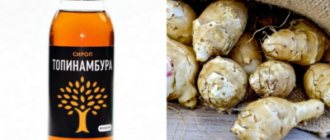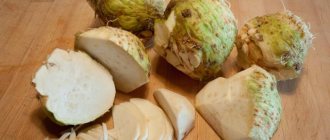Chemical composition and trace elements
Red radishes contain a large amount of minerals that heal and cleanse the body. At the same time, the low calorie content allows you to consume the product with virtually no restrictions .
| Fresh radish | Canned | Frozen | Tops | |
| Potassium | 233 | 333 | 230 | 270 |
| Sodium | 39 | 789 | 30 | 120 |
| Calcium | 25 | 28 | 23 | 30 |
| Phosphorus | 20 | 31 | 15 | 27 |
| Magnesium | 10 | 8 | 9 | 13 |
| Iron | 0,34 | 0,23 | 0,23 | 0,42 |
| Zinc | 0,28 | 0,22 | 0,25 | 0,34 |
The composition of the elements in finished dishes depends on what additional ingredients were used in preparation, and on the intensity and method of their processing. The most beneficial substances are found in fresh salads.
Attention! Data on the chemical composition may vary depending on the variety of radish and the place where it grows, and on the quality of soil saturation with minerals.
Chemical composition and calorie content of radishes, health benefits and harms of the vegetable
Radishes are one of the early vegetables that are the first to ripen in gardens. It has been on our tables for a long time and we enjoy its fresh and delicate taste.
But does everyone know about its beneficial properties and the substances it contains? This article describes in detail the composition of the root vegetable, its beneficial properties, and provides recommendations for its proper use in the human diet.
Nutritional value and nutritional value of radish
Women often wonder how many calories are in radishes.
100 g of red radish contains only 19 kcal , which makes it a dietary product suitable for consumption during fasting. The root vegetable contains 1.2 g of protein, 0.1 g of fat and 3.4 g of carbohydrates for every 100 g.
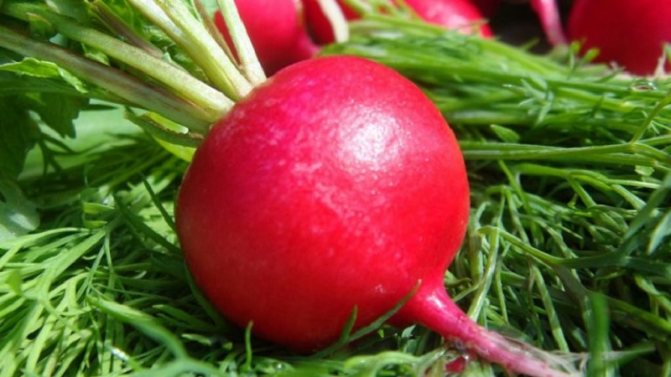
The nutritional value
For fresh radishes
One unit is taken to be a medium-sized root crop weighing 15 grams. According to Farmer.blog:
Radish leaves (tops)
For frozen
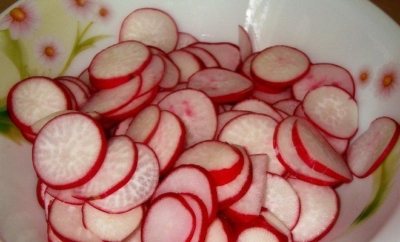
Contact with air affects the content of other components. It should be stored in a vacuum container without tops. When properly frozen, there is a negligible effect on the energy and nutritional value of the product. These changes can be neglected.
In the table you can find out how many carbohydrates, fats and other substances are contained in frozen vegetables:
What vitamins are contained in radishes?
In addition to the high content of minerals, the root vegetable contains high levels of vitamins C, PP, and group B. Mustard oil, which gives the vegetable a tart taste, increases appetite and has a positive effect on the absorption of vitamin C.
It is most beneficial to eat the tops of a young plant . It contains several times more vitamins, and their absorption is faster and in greater quantities. For consumption, you should choose small leaves without damage.
Attention! Radish tops have the same pronounced taste as the root vegetable itself. It can be added to borscht, soups, and used to prepare fresh salads and dressings for meat dishes.
Beneficial properties for the human body
The root vegetable not only enriches the body with useful substances, normalizing the vitamin and mineral balance in humans, but also generally has a beneficial effect on the functioning of internal organs.
Due to its use, it occurs:
- strengthening the walls of blood vessels and capillaries;
- improving the functioning of the digestive tract and cardiovascular system;
- increased absorption of vitamin C;
- removal of toxins and toxic substances from the body;
- acceleration of cell renewal, which helps to prolong youth;
- reduction of the inflammatory process in the initial stages of its development;
- reducing the risk of developing cancer, especially in the gastrointestinal tract, oral cavity and liver;
- lowering blood cholesterol levels;
- normalization of the nervous system;
- prevention of constipation and increased intestinal motility;
- preventing blood clots;
- normalization of blood sugar levels;
- improvement of skin condition, including in the presence of rashes;
- increasing the removal of fluid from the body, which has a beneficial effect on the heart and kidneys;
- improving dental and oral health.
Remember that radishes are beneficial only if consumed in moderation . It is not recommended to exceed the daily allowance of 300 g.
Application for weight loss
Radish is a low-calorie vegetable that is constantly included in diets for weight loss . But you cannot eat it uncontrollably, especially in mono-diets. Excessive absorption of radishes threatens serious disturbances in the digestive tract, the appearance of kidney and liver diseases.
To reduce body weight, in combination with other healthy foods and physical activity, it is recommended to eat 4-6 servings of salad with red radishes per week. For better absorption, the vegetable is combined with green salad, apples, celery and dill.
This combination has a beneficial effect on the functioning of the heart and allows you to include these salads in diets for the treatment of high blood pressure. To get the maximum effect, it is additionally recommended to drink plenty of liquid.
Use in folk medicine
Radish helps in the treatment of a number of serious diseases. When used correctly, it relieves swelling and increases muscle tone. Not only the fruits, but also the tops are used in treatment.
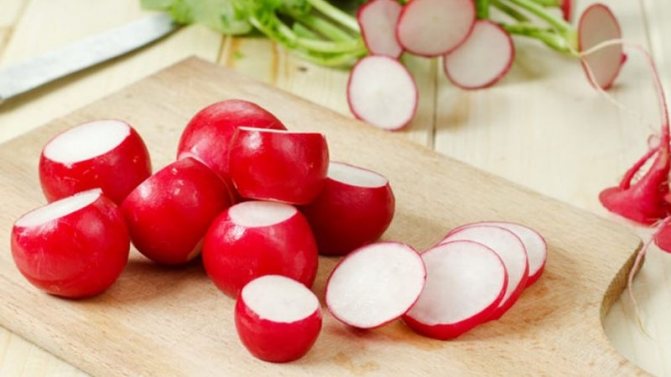
In the treatment of varicose veins
Several radish heads are ground into a pulp . Next, it is mixed with a small amount of lemon juice.
Rub the product with gentle massage movements 1-3 times a day into the affected areas of the legs. It is recommended to continue therapy for three weeks, after which a break for a month will be required. Radiculitis and neuralgia are treated in the same way.
When treating frostbite
Only mild injuries can be treated in this way . To do this, mix radish pulp and hot water in equal quantities. After this, the resulting mass is placed in sterile gauze and applied to the affected area. Keep the compress for no more than five minutes. If necessary, repeat the procedure after 30-60 minutes.
Application
Radishes are very rarely subjected to heat treatment; this vegetable should be eaten raw. It adds a piquant taste to vitamin salads. The most delicious fruits are those with a diameter of no more than 2 centimeters. Overripe radishes take on a rough, fibrous flavor. To make the vegetable even crispier, you need to soak it in cold water for 5-10 minutes before eating. Radishes can also be canned.
Market Analytics
- COVID-19 is changing the rules of the game in the cosmetics market
- Beauty of the future: cosmetic innovations 2020
- New ingredients are the driving force of the cosmetics industry
Convenient search for beauty salons on our website
Beauty salons in Moscow Beauty salons in St. Petersburg Beauty salons in Ekaterinburg Beauty salons in Novosibirsk
Latest blog posts on our website
- Naturecream / Geranium (Pelargonium) oil for skin health and beauty
- Prostye-sovety / Save on a beauty salon: procedures that can be done at home
- Naturecream / Growth Factor - brings back youth?
- Oksana-Lezina / 3 effective abdominal exercises from a fitness instructor for beginners
- Prostye-sovety / Making perfect curls at home
- Prostye-sovety / Which hair removal method to choose
- Naturecream / Wrinkles Puppets
- Naturecream / PEPHA-TIGHT - instant skin lifting
- Naturecream / Blue light - a danger to the skin
- Naturecream / Cocoa Butter – A treat for the skin
Latest forum topics on our website
- Mrs._Smith / Badly sunburned! What to do?((
- Ice / Is it necessary to combine fitness classes with a diet?
- Antonova / What can be used for hair loss?
- Radio operatorKat / Who was on a protein diet?
- Suzanna / Mesotherapy on the face
Other articles in this section
| Sun-dried tomato Tomatoes spoil quickly because they contain a lot of liquid. During the drying process, the liquid comes out, and the taste of the tomatoes remains for a long time. To dry tomatoes, you need a certain temperature regime, but this is easy to do at home. Sun-dried tomatoes do not contain many calories, so they are suitable for people on a diet |
| Beans Beans are the fruits of various plants of the legume family. These include lentils, soybeans, different types of beans and peas - in total more than 13 thousand plant species. Despite their small size, beans contain many nutrients, especially proteins. Beans are native to the Mediterranean and are a traditional crop in Greece. Due to their nutritional value, legumes are distributed throughout the world. Thus, in China, more than half of all cultivated land is devoted to legumes. |
| Sorrel Sorrel is a leafy vegetable similar to spinach. The homeland of this vegetable plant is in Europe, it is especially popular in Eastern European countries. The main component of sorrel is oxalic acid, thanks to which it acquires its unusual sour taste. |
| Turnips Turnips are a root vegetable of the cruciferous family. In European and Asian cuisine, the root vegetable itself, stems, and leaves are used. As a rule, turnip fruits are round in shape and can weigh up to 1 kg. Turnips have been known in the Middle East for more than 4 thousand years; they were highly valued by the Greeks and Romans for their nutritional value and sweet taste. Turnips occupied the main place in the diet of the European population until potatoes were brought to Europe. And in Russian cooking it remained the main vegetable until the twentieth century. There are many varieties of turnips, the most common being yellow and white turnips. |
| Boiled potatoes Potatoes are a starchy root vegetable of South American origin. The average height of a potato bush is 30-40 cm; tubers located underground are eaten. Potato tubers are considered ripe when the above-ground part of the plant dries out. |
| Romanesco cabbage Romanesco is the most unusual member of the cruciferous family. This variety is closest to broccoli and cauliflower. Its inflorescences are organized in a strict sequence, reminiscent of the classical Fibonacci series in mathematics. The inflorescences form a spiral, and each spiral consists of a group of similar small spirals. This fractal pattern repeats itself many times as the inflorescences become smaller. Romanesco cabbage was first mentioned in Italian sources of the 16th century. It was developed on the northwestern coast of the Mediterranean from wild kale. |
| Arracacha Arracacha is a root vegetable of the Umbelliferae family from Latin America, related to carrots and celery. Most common in Brazil, Colombia, Ecuador and Venezuela. The harvest season lasts from January to September. Unlike potatoes, which were brought to Europe from Latin America, arracacha is a very rare vegetable for mid-latitudes. Fruits develop only under certain temperature conditions; root ripening lasts several months. It is very difficult to grow this crop in a continental climate. In Venezuela this vegetable is called “Creole celery”, and in Ecuador it is called “white carrot”. In Brazil, arracacha is grown on an industrial scale. There are several varieties of root vegetables - yellow, orange and white. |
| Pickled capers Capers are considered a delicacy and are used as a seasoning in Italian cuisine. These are immature buds of the wild caper plant. It does not like frost and grows in Southern Europe only at above-zero temperatures. It is difficult to grow capers on purpose; they prefer places sheltered from the wind - along walls and hedges. |
| Daikon Daikon is the Japanese name for white radish, which translates to “big root.” The Mediterranean is considered the birthplace of this root crop, and from the 5th century. BC. it began to be grown in China and then in Japan. Now in Japan, daikon is the most popular vegetable. |
| Head lettuce All types of lettuce are divided into leaf and head lettuce. Thus, cabbage varieties include Iceberg, Batavia and others. Head lettuce is a mid-season variety and is easy to grow. It only needs constant watering, and it is unpretentious to the soil and can withstand light frosts. Lettuce is one of the most popular vegetable crops, which is cultivated in most countries of Europe, America, and Asia. |
Harm and contraindications to consuming radishes
The root vegetable has pronounced antiseptic and bactericidal properties . But this feature made radishes dangerous for consumption in the following cases:
- period of exacerbation of diseases of the digestive tract;
- inflammatory process in the thyroid gland;
- peptic ulcer and inflammation of the pancreas;
- goiter and hyperabsorption of vitamins in the body;
- the presence of foci of gastritis on the gastrointestinal mucosa;
- period of exacerbation of kidney and liver diseases, including those of a chronic nature;
- recovery period after a heart attack.
If you have gastrointestinal diseases during their remission, you are allowed to eat a small portion of radishes . It is recommended to choose varieties with less mustard oil content. If a person has tachycardia, one should refrain from eating the root vegetable, as its essential oils increase blood flow and pulse.
Attention! If you have chronic disorders of the digestive tract, it is recommended to consult a gastroenterologist before consuming radishes.
Calorie content of radish per 100 g
This vegetable is considered a low-calorie product, but has one peculiarity: the longer it is stored, the more its calorie content increases. This occurs due to the accumulation of starch in the tissues.
Fresh
Energy value of radishes picked from the garden:
- proteins: 1.2 g (about 5 kcal).
- fat: 0.1 g (1 kcal).
- carbohydrates: 3.4 g (about 10 kcal).
The percentage ratio of BJU is 24:5:68%. The calorie content of fresh radishes is 16 kcal per 100 g.
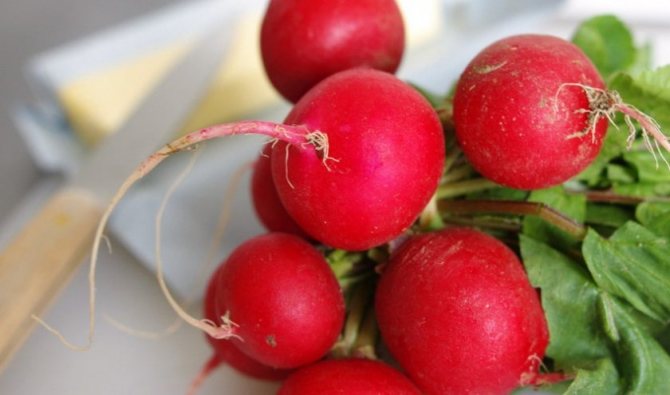
Chemical composition
Radishes contain various vitamins, in particular the following:
- C - 25 mg;
- PP (niacin equivalent) - 0.30 mg;
- B5 - 0.20 mg;
- B6 - 0.10 mg;
- E (tocopherol) - 0.10 mg;
- B2 (riboflavin) - 0.04 mg;
- B1 (thiamine) - 0.01 mg;
- B9 - 6 mcg.
This vegetable is rich in minerals:
- potassium - 255 mg;
- copper - 150 mg;
- chlorine - 44 mg;
- phosphorus - 44 mg;
- calcium - 39 mg;
- magnesium - 13 mg;
- sodium - 10 mg;
- iron - 1 mg;
- zinc - 0.20 mg;
- manganese - 0.15 mg;
- vanadium - 185 mcg;
- iodine - 150 mcg;
- boron - 100 mcg;
- fluorine - 30 mcg;
- lithium - 23 mcg;
- nickel - 14 mcg;
- chromium - 11 mcg;
- cobalt - 3 mcg.
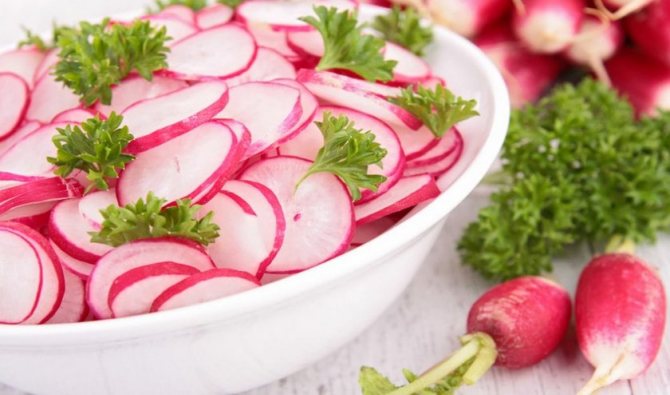
Useful properties of radish
Radishes have many beneficial properties due to their composition, which is rich in B vitamins, minerals (potassium, phosphorus, sodium, calcium, magnesium), ascorbic acid, proteins and fiber.
The root vegetable contains fats, sugar, enzymes and organic acids, which are beneficial for the gums, teeth, circulatory and musculoskeletal systems.
Radishes are highly beneficial for people with excess weight, cardiovascular diseases, problems with the digestive system and circulatory disorders.
In Eastern medicine, the beneficial properties of radishes have been appreciated for a long time. The benefits of radish have been revealed as a rejuvenating agent that affects intercellular membranes, improving their permeability and ability to absorb nutrients.
The fiber contained in this vegetable helps remove cholesterol and harmful substances from the body. In terms of fiber content, radishes are similar to tomatoes, garlic, beets and cabbage, but are 2 times higher than zucchini.
Radishes also contain useful substances that normalize blood sugar levels.
For headaches, fresh juice of this vegetable is effective, and for injuries, radiculitis, bruises, sprains and joint pain, compresses with chopped radishes are applied.
In cosmetology, nourishing masks with finely chopped radishes and the addition of olive oil are used.
The beneficial properties of radishes are manifested in the prevention of atherosclerosis and for improving appetite. Radish juice is a decongestant, choleretic and anti-inflammatory agent.
The benefits and harms of radishes
- Positive properties of this vegetable crop:
- Both roots and even leaves contain a natural antiseptic substance - mustard oil. A fresh cut of the vegetable can be applied to the wound, and eating it promotes healing of the mucous membranes of the internal organs.
- Radishes increase appetite and have a positive effect on the gastrointestinal tract.
- The plant anthocyanins contained in the product have the ability to stop the spread of cancer cells.
- Radishes are effective as a detox product: they reduce the amount of bad cholesterol and remove toxins from the body.
- In the active phase of respiratory diseases and during recovery, the vegetable will help strengthen the immune system.
- Tincture of radish tops relieves inflammation in the oral cavity.
- This vegetable is useful in the diet.
- Despite the great benefits, there is also harm from this vegetable crop:
- Long-term storage of radishes leads to the appearance of coarse fibers in the pulp. As a result, such a vegetable is poorly digested and irritates the mucous membranes of the stomach and intestines.
- The product is strictly contraindicated for ulcer sufferers and those suffering from chronic gastritis.
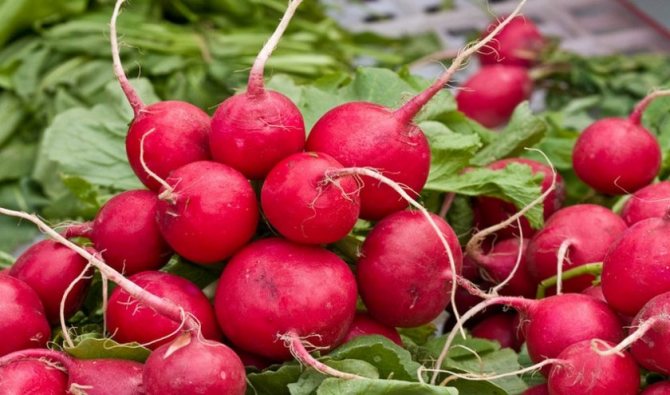
Benefits of radishes
The beneficial properties of radishes have been known for a very long time, but they still amaze with their diversity and versatility. The benefit of radish is in its composition, which is replete with vitamins, micro- and macroelements. The fruits and green mass of radishes contain mustard oil, which has an antiseptic effect, so radishes are used to treat wounds; it is also effective for lesions of the mucous membrane of internal organs.
Radishes stimulate appetite and generally have a very beneficial effect on the functioning of the gastrointestinal tract. Plant anthocyanins were found in radishes, which, according to research, can block the development of cancer cells. In addition, radishes remove harmful cholesterol and toxins from the body. Radishes increase immunity and promote the body's active fight against colds. It is also useful during the recovery period after these diseases.
Radishes have also received attention from traditional medicine. An infusion of radish tops is used to eliminate inflammatory processes in the oral cavity. The benefits of radishes have also been proven if you want to lose weight. The calorie content of radishes is only 20 kcal. per 100 gr. Therefore, it will come in handy in the diet. But it should be remembered that it is necessary to observe moderation in the use of this vegetable, otherwise you can learn first-hand about the dangers of radishes.
